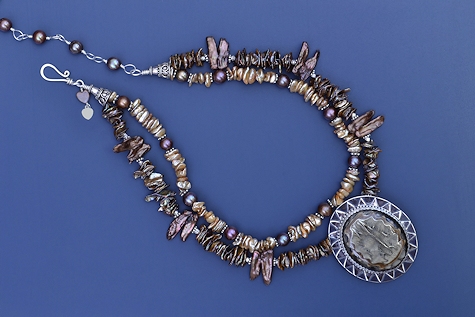The centerpiece of this necklace is a fossil ammonite, surely one of the most amazing fossils I've ever used. It is cut to show a single chamber (called a camera) and the natural zigzag septa around the edge which separated this chamber from the rest. The edge is highly polished as are the surfaces of the "saguaros" in the center. The concave background is encrusted with drusy pyrite and shoots off beautiful tiny sparkles as you can see in Barry Blau's photo (second one down on black background). Although the cutter did not specify the source of the fossil, it is probably from the Volga River area of Saratov, Russia. It probably lived about 150 million years ago during the Jurassic. The sea where this creature lived had a high iron concentration. The iron reacted with sulphur in the water forming the iron pyrite which gradually replaced the ammonite tissue, leaving this incredible stone.
I am often asked if my ammonites are a type of Nautilus, however this extinct animal is more closely related to modern coleoids like the octopus. In fact, traces of ancient ink have been found in some specimens. As it grew, the ammonite lived in the outermost (largest) chamber, and used the other chambers for flotation. As the animal continued to lay down new chambers, it grew into a natural Fibonacci (Golden Ratio) spiral.
Note that these fossils have nothing to do (as far as I can tell) with the Ammonite people mentioned in the Old Testament who came from Ammon, a nation in eastern Palestine.
So, what can be done with a fossil like this? I settled on a simple setting with a sterling overlay on the front to echo the septa and on the back a roadrunner to complement the Saguaro theme.
Melody says ammonite can be helpful for architects, undoubtedly because of the beautiful design of its living quarters. Wouldn't you enjoy a spiraling domicile? In lieu of such an extravagance, I hope you will order this piece and revel in its ancient stories of the sea.









